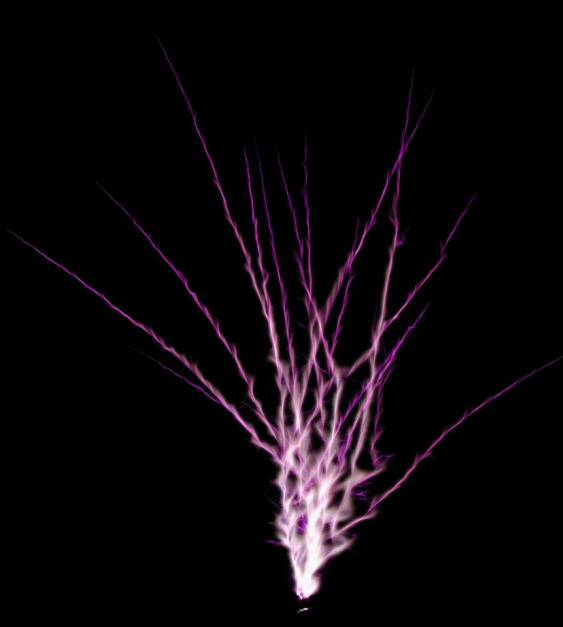The Interconnected Sun Part One
Feb 03, 2010
The Sun/Earth Connection
Plasma is often described as the
fourth state of matter. Since it
makes up more than 99% of the
Universe, it should be reckoned the
first state. As has been proposed in
previous articles, the Sun is an
example of plasma and its normal
behavior.
Although the general premise is
probably thousands of years old—that
Earth is somehow an electrical
entity—it has only been in the last
100 years that scientists have given
serious credence to the possibility
that we could be living in a dynamic
Solar System where electricity plays
an important role. The Sun's
electric field extends for billions
of kilometers, influencing the
planets in their motions, as well as
how they interact with each other.
In September of 2002, a major
premise of Electric Universe theory
was confirmed: weather systems on
Earth are electrically connected to
the field of charged particles
called the ionosphere. Dual bands of
plasma shining in ultraviolet light
were detected by the IMAGE
satellite. The plasma streams are
circling the Earth in opposite
directions along the equator,
carrying positive and negative
electric charges.
Since plasma is a charged substance,
if it is in motion it will generate
an electric current. An electric
current flowing through plasma
creates a tube-like magnetic sheath
that "squeezes" the current to form
one or more filaments . If enough
current passes through the circuit,
the plasma current filaments will
glow, sometimes creating one or more
"double layers" of charge separation
along the current axis.
Double layers form when a current
flows in plasma and positive and
negative charges build up in
adjacent regions along the current
flow. A powerful electric field
appears between the two regions,
which accelerates charged particles.
Hannes Alfvén considered double
layers an important cosmic circuit
element.
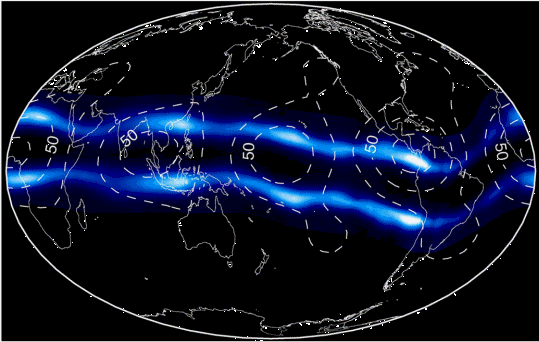
Plasma
bands in the ionosphere emitting
ultraviolet light. Credit:
NASA/University of California,
Berkeley.
Another example of the Sun's
intimate association with Earth are
the polar aurorae. The curtains of
blue, green, and red that hang down
from the sky like wind-wavering
veils of color have both puzzled and
entranced observers for countless
millennia. In 1621, Pierre Gassendi
called the shimmering lights seen in
the Arctic the Aurora Borealis after
Aurora, the Roman goddess of dawn,
and Boreas, the Greek name for the
north wind. In the south polar
region the same phenomenon appears
and is known as Aurora Australis,
literally "Southern Dawn" in Latin,
or more conventionally, "Southern
Lights".
Solar ions follow Earth's
magnetic field down into the poles,
causing atmospheric molecules to
emit light: red from oxygen at high
altitudes, then green from oxygen
lower down, along with blue from
nitrogen. The electric charges
travel down magnetic flux tubes that
have recently been discovered. These
"electromagnetic funnels" are
several kilometers wide and allow
electric currents to flow directly
from the Sun into the polar regions,
generating colorful visible light,
radio waves, and X-rays.
The power generated by electric
currents in auroral storms is far
greater than anything that human
beings can create with every
coal-burning, oil-fired, or
water-driven means combined. These
currents are composed of widely
separated, low density charged
particles and are called Birkeland
currents. Despite the low current
density, the volume of charge is so
great that the current flow can
exceed one million Amperes.
Recently, the Time History of
Events and Macroscale Interactions
during Substorms (THEMIS) satellites
detected "space tornadoes", vortices
of electrified plasma rotating
faster than 1,600,000 kilometers per
hour. These helical storms of
electromagnetic energy were found
approximately 64,000 kilometers from
Earth. The five THEMIS satellites,
together with Earth-based stations,
verified their connection with the
ionosphere.

Aurora
Australis over the Bellingshausen
Sea.
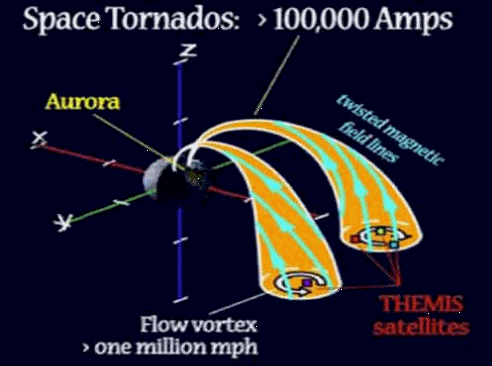
Electromagnetic vortices flowing
into Earth's poles. Credit: Andreas
Keiling/UC Berkeley.
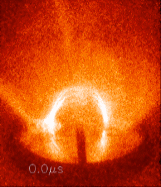
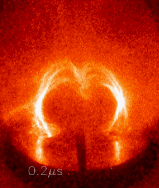
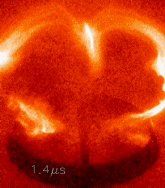
Laboratory simulation of solar
plasma flux tubes. Time index 0 -
1.4 microseconds.
To view a movie of the
electrically active solar wind
particles interacting with Earth's
plasmasphere
click here.
Stephen Smith
|




